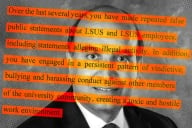You have /5 articles left.
Sign up for a free account or log in.
The current model of higher education was several centuries in the making. That leaves colleges adapting to online learning, a viable option for only about a decade, with a monumental game of catch-up.
As online courses' popularity continues to rise, many administrators are struggling with a steep learning curve, one whose ultimate end point is far from being determined. Questions such as how such courses should be taught (by adjuncts or full-time faculty?) often depend on institutions' missions (expand access or generate extra revenue?) and can lead to clashes and tensions between proponents of online learning and those who remain wedded to the traditional classroom.
But it's often the existing campus faculty that administrators rely on to develop and teach online courses, a reality that informs their approaches to determining who should teach the courses and how they should be compensated. In many cases, the models are relics of outdated distance programs that gradually became the basis for courses offered over the Internet. No two models are exactly alike, but as colleges experiment with ways to keep their faculty happy and their courses high in quality, evidence of some common practices is emerging.
The University of Iowa recently learned the hard way how not to compensate faculty who teach online. Its model, carried over from decades of offering correspondence courses by mail, compensated professors for each extra class given per semester, and in the case of those taught online, pay was determined on a per-student basis.
The result, as reported by The Des Moines Register earlier this month, was that a handful of professors taught an unusually large number of extra courses beyond the regular two per semester, some online and some traditional, that left the university with an eye-catching bill. One professor, for example, taught eight online and two traditional courses last year -- in addition to his two usual per semester -- racking up a bonus of over $120,000, more than his base salary.
Usually, said Wallace Loh, the university's provost, he has the opposite problem -- trying to persuade faculty members to give time and effort to develop and teach online courses. He's now considering ways to make those incentives work, starting with instituting rules that will limit so-called overload pay by allowing only one extra course (online or not) per semester and capping enrollment in online courses to 36.
"I don't think you can do justice to your students and your classes if you're teaching that much, even if your sections have a relatively few number of students," he said.
Until the past few years, when growth in online enrollments started skyrocketing, Loh said, the costs were relatively low and the compensation structure for courses taught via the Internet remained the same as for those once taught via snail mail. Those days are now past, due in part to the well-documented rise in the enrollment of non-traditional students, those older than the typical on-campus undergraduate, often working part time or looking for mid-career training.
Yet at least 40 percent of the online enrollments at the university, Loh continued, come from right under his nose: traditional college-age students attending classes on the campus. Part of the explanation comes from simple scheduling conflicts, he noted, or mere convenience. Since online courses don't operate on as strict a timeline as those given on the semester system, it's also harder to count how many students are enrolled in each course; some could be finishing work from a previous year, for example.
"Our problem is we have to go around imploring people to teach additional classes," he explained. "Teaching an online class is far, far more complicated than teaching a regular class because, first of all, they have to ... totally restructure their class, [because] they have to be online."
That leaves two basic approaches: either support individual faculty members with the resources, pay and time they need to develop online courses that they can teach online, or invest in a centralized course creation department that would then outsource its teaching to adjuncts -- essentially a "high-quality assembly line," as Loh called it, akin to the for-profit University of Phoenix model.
But, like Iowa, many public institutions have the more modest goal of increasing access for their students and for residents of their states. And in that case, nudging faculty to teach online makes sense, even as the mechanisms for supporting them continue to be developed and as colleges balance growth with quality, financial resources with expanded enrollments.
When asked if he had settled on the right solution, Loh laughed. "I wish I did," he sighed.
Converging Models?
But as other colleges feel their way through the world of online education, at least some similarities are becoming apparent.
"I really think the key to all of this will be, how do you support the faculty member?" said Jeff Seaman, co-director of the Babson Survey Research Group.
The group, based at Babson College, is in the process of sifting through almost 9,000 faculty responses for a forthcoming survey on their views of online education. "Faculty uniformly believe that it does take more effort to develop an online course than it does to develop a face-to-face course," and to deliver it, Seaman said. "What we heard is that, 'I've not done this before, it's a different way of thinking about the course, it involves different skills....' "
Another recent Babson study, supported by the Sloan Consortium, found that about one in five students last year had taken an online course, up from virtually nil a decade ago. That demand is beginning to be felt at institutions with growing online enrollments, whether or not their faculty are willing to go along for the ride. "[E]ither they have enough of a subset of their faculty who do believe in it, or they're moving outside their institutions" to staff online courses, he said.
There are not enough data yet to tell which option colleges are choosing, or if it's a mix, but it's likely that such a decision would be at least partially determined by the kind of mission intended for online education, whether that of broad access or a more profit-centered, outsourced model.
Underlying these considerations is students' gradual acceptance of online classes as a legitimate and substantive alternative to those taught in person, and the increasing tendency of students to pick and choose their courses without regard for medium.
"How do you mainstream, if you will, this online learning and do it in a way that is reasonable and defensible and fair to everybody who's involved?" said Janet K. Poley, president of the American Distance Education Consortium, which is collaborating on the ongoing study with Babson. "I don't think in the long term you want to say, well, because you're located in a living unit on campus or an apartment near campus and would normally be considered a residential student, that you can't take online learning."
Part of that transition is ensuring that faculty members are compensated properly for their work, regardless of whether they're teaching online or face to face.
"My biggest concern is frankly ... that faculty who are teaching in the online environment are treated fairly. And I think there shouldn't be any huge difference between people who are teaching in the online environment and people who are teaching, period," Poley said. That would preclude such occurrences of "gaming the system" like those reported at Iowa, she added.
"My view in terms of where the future is headed and how fast it gets there and at which institutions," she said, is that "we are without question moving toward an era where a credit hour is a credit hour, a course is a course, whether it's taught face to face, whether it's taught in the online environment, whether it's taught in a blended environment."
Faculty unions agree that faculty members should be treated similarly when they teach online, both in terms of compensation and in terms of academic freedom and control of the curriculum. The American Federation of Teachers, for example, argues that "distance ed ought to be treated pretty much like all other courses and not as attached to quote-unquote 'normal' classes," said Craig Smith, associate director of the union's higher education department.
Poley said that some colleges, in the rush to adapt, offered faculty incentives in cash, even though what many professors want isn't necessarily more pay but release time, support services for course development or money for their home department or school.
Models that work, she continued, tend to include support for instructional design as well as "monetary return to the unit that is doing the work," so that compensation doesn't just feed back into the "tuition cloud."
"One of the models that was discussed ... is one where there is some overload pay or release time to faculty in the department for two or three years when they're mounting a new online offering, when they're going from a face-to-face to getting a course up, because it's really the design, development part that I think is harder than actual teaching ... and then there's some reward to faculty for doing that," Poley said.
And after a course has been sufficiently developed and "mainstreamed," the additional resources for development are no longer needed.
Faculty Incentives
The unique Indiana Partnership for Statewide Education consists of about 20 public and private institutions in the state that work together to offer courses from a central repository.
"We're constantly working to incentivize faculty to provide their own courses in our online format, because students are demanding it nowadays," said Mark Pagano, dean of continuing education and conferences at Purdue University, where he said most students have at least one online course on their record by the time they graduate.
The university is in the process of putting together a task force to evaluate its current model for distance education. But for now, Pagano said, it has worked fairly well. His office coordinates incentives, which can be "what makes sense" for a particular situation: for example, paying a faculty member "over and above" his or her salary for developing an online course, with dean and departmental approval. That can also include support for the home department.
Other cases are more routine. For courses with dozens of sections, for example, faculty members might teach one or two of those sections online without any need for additional incentives.
At Ohio State University, said Bobby Moser, its vice president for outreach, a portion of revenue from online courses is set aside to "stimulate new ideas in course work," an approach that allows for a couple years of support for faculty members and keeps the process competitive -- not every professor's proposal is accepted.
The process is more specific at Oregon State University, which has what David A. King, associate provost, called an "80/10/10" system. For any given online course, 80 percent of the revenue goes directly to the faculty member's college, and much of it may end up at his or her specific department for the development of additional courses. Ten percent goes to the administration, and the rest is sent to Extended Campus, the central entity that offers and supports the courses.
"For the most part, it's a business model that is very enticing and motivating for faculty to step up and try to develop courses," he said, adding that in many cases it is release time, not necessarily money, that attracts professors.
For each professor teaching an online course, the course development fund provides $1,000 to $4,000 directly, in addition to release time and support in instructional design and multimedia work. Some colleges, such as the College of Agricultural Sciences, even match the dollar amount.
The university offered 51,000 credit hours online last year, King said, with annual increases of 14 to 20 percent. Some colleges and departments are adding more graduate students to staff and teach the courses, he said, a possible way to avoid having to hire adjuncts. And so far, the challenge is to get existing faculty interested in teaching online, rather than preventing them from exceeding some course limit.
"If there is [a limit], we haven't found it."








